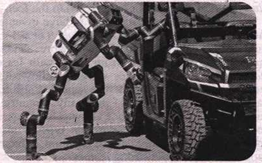题目内容
C

Contestants from around the world met in Pomona, California,this month to test their skills at things like driving a car,walking down stairs,and opening doors. Sounds easy,right? But the competitors weren't people — they were robots!
The bots were participating in the final round of the US,s DARPA (Defense Advanced Research Projects Agency) Robotics Challenge. This event,which took place on June 5-6,tested robots on how well they could respond during a disaster and the winning team finally took home a $2 million grand prize.
The DARPA challenge was created after the 2011 Fukushima nuclear disaster in Japan. An earthquake caused a tsunami,which damaged a nuclear power plant. Workers at the plant needed to shut bff an important valve(阀门) ,but it was too dangerous for humans to reach it. The US scientists at DARPA wondered whether the disaster could have been avoided if a robot had been sent to do the job. So they set up the robotics competition.
Turning a valve was just one task a robot might have to perform when entering a disaster zone. In addition to doing this,robots participating in the challenge had to navigate a course containing several other tasks: driving and exiting a vehicle, opening a door,walking over or clearing objects,cutting a hole in a wall,plus climbing a flight of stairs.
Teams had to complete the challenge in one hour,and points were awarded based on how quickly the robots completed a task. They didn't have to attempt all the tasks. To make things even more realistic,challenge organizers caused short computer-system blackouts(断电) that prevented robots and the human operators controlling them from communicating. That means teams had to program their bots to be partially autonomous (独立的) . Robots also couldn’t be attached to anything that could keep them from falling down , which happened a lot.
29.What do we know about this year's DARPA challenge?
A. It lasted five days.
B. It was held in Japan.
C. Its winner got a cash prize.
D. Its winner will work in Fukushima.
30.What does the underlined part “the job” in Paragraph 3 refer to?
A. To open a door.
B. To close a valve.
C. To predict a tsunami.
D. To rebuild a nuclear power plant.
31.The robots that participated in the US,s DARPA challenge were required to .
A. challenge all the tasks
B. have a good sense of smell
C. complete their tasks in an hour
D. act in the dark in the whole process
32.What is the text mainly about?
A. A nuclear disaster.
B. A research program.
C. A robotics competition.
D. A scientific organization.
C篇(现代技术)
本文是说明文。文章介绍了在加利福尼亚州举行的DARPA机器人挑战赛。
29. C. 细节理解题。由第二段的the winning team finally took home a $2 million grand prize可知,加利福尼亚州 举行的为期两天的DARPA机器人挑战 赛冠军得主获得了200万美元的现金大奖。
30. B. 篇章结构题。划线部分所在句的 the disaster指代上文的福岛核电站事 故,科学家认为如果当时能有机器人去关闭核电站的阀门,那么那场事故就会避免,故此处的the job指关闭阀门。
31. C. 细节理解题。由最后一段介绍机器: 人参赛规则的 Teams had to complete the challenge in one hour可知,参赛机器人需要在一个小时之内完成比赛内容。
32. C.主旨大意题。本文主要介绍了在加利福尼亚州举行的DARPA机器人挑战赛赛况及其规则。

 优生乐园系列答案
优生乐园系列答案 新编小学单元自测题系列答案
新编小学单元自测题系列答案